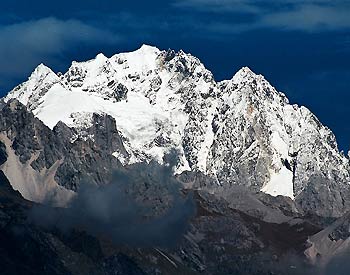| Tools: Save | Print | E-mail | Most Read |
| Expert: Yulong Glacier Will Not Disappear |
| Adjust font size: |
A glacier expert from the
"It receded significantly during this time, but the glacier has already begun to show signs of advancing," Dr. He Yuanqing, an expert in glaciers and geomorphology with the CAS, said in a recent interview with Chuncheng Evening News. According to the March 20 report, He, graduating from the University of Manchester in the UK, believes that non-simultaneous changes in temperature and levels of precipitation could create stable long-term conditions for the glacier. Located The mountain has 19 glaciers. He says that the long-term effects of sustained low temperatures and increased levels of precipitation lead to glacial accumulation that is greater than glacial ablation, thereby creating lower snow lines. According to statistics, He says the Baishui No.1 Glacier was 4,500 meters above sea level in 1956 and He postulates that the most important factor affecting glacial growth is the climate. Yulong Snow Mountain's snow line is approximately 4,800 meters at present. The annual average temperature in the vicinity of the snow line is 3.3-4.7ºC. Annual precipitation levels are between 2,500 and The area above the snow line, covering only a maximum of about 18 sq km, is too fragile to withstand any major change in climate such as a global or regional rise in temperatures. However, He points out that the area around the mountain is comparatively less polluted than other parts of the region. This is because there are fewer heavy industry factories and vegetation cover is denser. Further, He says that according to data on the climate in northeast India and glacial changes of Yulong Snow Mountain over the last 50 years, there exist natural climate conditions conducive to the continued survival of the glacier. The southwest monsoon climate, which is indigenous to the area, operates roughly in a cycle of 11 to 12 years, thus maintaining a balance between temperature changes and precipitation levels.
(China.org.cn by Zhang Tingting, March 24, 2006) |
| Tools: Save | Print | E-mail | Most Read |
 |
| Related Stories |
| Product Directory China Search |
Country Search Hot Buys |

